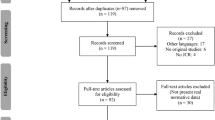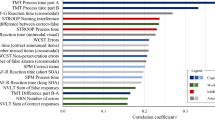Abstract
Semantic verbal fluency test is frequently used in clinical practice to assess lexical retrieval and production in neurological and psychiatric diseases. Semantic category is a crucial variable to consider in patients with language disorders. Norms for this task were collected from a population of 290 Italian healthy participants with age ranging from 18 to 98 years. The aim was to provide normative data both for the global score and for each semantic category (animals, fruits, brands of cars). Multiple regression analysis revealed that age and education significantly correlated with the global score and with single semantic categories. In particular, increasing age negatively affected performance, whereas the performance increased with a higher education. Statistically significant differences between men and women were found only for brands of cars. The availability of equivalent scores for the single semantic categories will prove useful in clinical practice since it allows the comparison of single semantic categories in patients with language disorders.
Similar content being viewed by others
References
Lezak MD (2004) Neuropsychological assessment, 4th edn. Oxford University Press, UK
Birn RM, Kenworthy L, Case L, Caravella R, Jones TB, Bandettini PA, Martin A (2010) Neural systems supporting lexical search guided by letter and semantic category cues: a self-paced overt response fMRI study of verbal fluency. Neuroimage 49(1):1099–1107. doi:10.1016/j.neuroimage.2009.07.036
Baldo JV, Shimamura AP (1998) Letter and category fluency in patients with frontal lobe lesions. Neuropsychology 12(2):259–267
Henry JD, Crawford JR (2004) A meta-analytic review of verbal fluency performance in patients with traumatic brain injury. Neuropsychology 18(4):621–628. doi:10.1037/0894-4105.18.4.621
Phillips TJ, James ACD, Crow TJ, Collinson SL (2004) Semantic fluency is impaired but phonemic and design fluency are preserved in early-onset schizophrenia. Schizophr Res 70(2–3):215–222. doi:10.1016/j.schres.2003.10.003
Gardini S, Cuetos F, Fasano F, Pellegrini FF, Marchi M, Venneri A, Caffarra P (2013) Brain structural substrates of semantic memory decline in mild cognitive impairment. Curr Alzheimer Res 10(4):373–389. doi:10.2174/1567205011310040004
Venneri A, McGeown WJ, Hietanen HM, Guerrini C, Ellis AW, Shanks MF (2008) The anatomical bases of semantic retrieval deficits in early Alzheimer’s disease. Neuropsychologia 46(2):497–510. doi:10.1016/j.neuropsychologia.2007.08.026
Ibarretxe-Bilbao N, Junque C, Marti MJ, Tolosa E (2011) Brain structural MRI correlates of cognitive dysfunctions in Parkinson’s disease. J Neurol Sci 310(1–2):70–74. doi:10.1016/j.jns.2011.07.054
Baldo JV, Shimamura AP, Delis DC, Kramer J, Kaplan E (2001) Verbal and design fluency in patients with frontal lobe lesions. J Int Neuropsychol Soc 7(5):586–596
Hodges JR, Patterson K, Waed R, Garrard P, Bak T, Perry R, Gregory C (1999) The differentiation of semantic dementia and frontal lobe dementia (temporal and frontal variants of fronto-temporal dementia) from early Alzheimer’s disease: a comparative neuropsychological study. Neuropsychology 13(1):31–40
Baldo JV, Schwartz S, Wilkins D, Dronkers NF (2006) Role of frontal versus temporal cortex in verbal fluency as revealed by voxel-based lesion symptom mapping. J Int Neuropsychol Soc 12(6):896–900. doi:10.1017/S1355617706061078
Warrington EK, Shallice T (1984) Category-specific semantic impairments. Brain 107:829–859
Martin A (2007) The representation of object concepts in the brain. Annu Rev Psychol 58:25–45. doi:10.1146/annurev.psych.57.102904.190143
Caramazza A, Shelton JR (1998) Domain-specific knowledge systems in the brain: the animate-inanimate distinction. J Cogn Neurosci 10(1):1–34. doi:10.1162/089892998563752
Farah MJ, Wallace MA (1992) Semantically-bounded anomia: implications for the neural implementation of naming. Neuropsychologia 30(7):609–621
Caramazza A, Mahon BZ (2003) The organization of conceptual knowledge: the evidence from category-specific semantic deficits. Trends Cogn Sci 7(8):354–361. doi:10.1016/S1364-6613(03)00159-1
Gainotti G (2005) The influence of gender and lesion location on naming disorders for animals, plants and artefacts. Neuropsychologia 43(11):1633–1644. doi:10.1016/j.neuropsychologia.2005.01.016 (Epub 2005 Feb 25)
Gainotti G, Ciaraffa F, Silveri MC, Marra C (2009) Mental representation of normal subjects about the sources of knowledge in different semantic categories and unique entities. Neuropsychology 23(6):803–812. doi:10.1037/a0016352
Damasio H, Grabowski TJ, Tranel D, Hichwa RD, Damasio AR (1996) A neural basis for lexical retrieval. Nature 380(6574):499–505. doi:10.1038/380499a0
Capitani E, Laiacona M, Mahon B, Caramazza A (2003) What are the facts of semantic category-specific deficits? A critical review of the clinical evidence. Cogn Neuropsychol 20(3):213–261. doi:10.1080/02643290244000266
Gainotti G (2000) What the locus of brain lesion tells us about the nature of the cognitive defect underlying category-specific disorders: a review. Cortex 36(4):539–559
Papagno C, Gallucci M, Casarotti A, Castellano A, Falini A, Fava E, Giussani C, Carrabba G, Bello L, Caramazza A (2011) Connectivity constraints on cortical reorganization of neural circuits involved in object naming. Neuroimage 55(3):1306–1313. doi:10.1016/j.neuroimage.2011.01.005
Gainotti G (2011) The organization and dissolution of semantic-conceptual knowledge: is the ‘amodal hub’ the only plausible model? Brain Cogn 75(3):299–309. doi:10.1016/j.bandc.2010.12.001
Novelli G, Papagno C, Capitani E, Laiacona N, Vallar G, Cappa SF (1986) Tre test clinici di ricerca e produzione lessicale: taratura su soggetti normali. Archivio Psicologia, Neurologia Psichiatria 47(4):477–506
Spinnler H, Tognoni G (1987) Standardizzazione e taratura italiana di test neuropsicologici (Italian standardization of neuropsychological tests). Ital J Neurol Sci (suppl. 8):1–120
Capitani E, Laiacona M, Barbarotto R (1999) Gender affects word retrieval of certain categories in semantic fluency tasks. Cortex 35(2):273–278
Costa A, Bagoj E, Monaco M, Zabberoni S, De Rosa S, Papantonio AM, Mundi C, Caltagirone C, Carlesimo GA (2013) Standardization and normative data obtained in the Italian population for a new verbal fluency instrument, the phonemic/semantic alternative fluency test. Neurol Sci 35(3):365–372. doi:10.1007/s10072-013-1520-8
Brucki SMD, Rocha MSG (2004) Category fluency test: effects of age, gender and education on total scores, clustering and switching in Brazilian Portuguese-speaking subjects. Braz J Med Biol Res 37(12):1771–1777. doi:10.1590/S0100-879X2004001200002
Casals-Coll M, Sánchez-Benavides G, Quintana M, Manero RM, Rognoni T, Calvo L, Peña-Casanova J et al (2013) Spanish normative studies in young adults (NEURONORMA young adults project): norms for verbal fluency tests. Neurología 28(1):33–40. doi:10.1016/j.nrl.2012.02.010
Cavaco S, Gonçalves A, Pinto C, Almeida E, Gomes F, Moreira I, Teixeira-Pinto A et al (2013) Semantic fluency and phonemic fluency: regression-based norms for the Portuguese population. Arch Clin Neuropsychol 28(3):262–271. doi:10.1093/arclin/act001
Tallberg IM, Ivachova E, Jones Tinghag K, Ostberg P (2008) Swedish norms for word fluency tests: FAS, animals and verbs. Scand J Psychol 49(5):479–485. doi:10.1111/j.1467-9450.2008.00653.x
Troyer AK (2000) Normative data for clustering and switching on verbal fluency tasks. J Clin Exp Neuropsychol 22(3):370–378. doi:10.1076/1380-3395(200006)22:3;1-V;FT370
Van der Elst W, Van Boxtel MPJ, Van Breukelen GJP, Jolles J (2006) Normative data for the animal, profession and letter M naming verbal fluency tests for Dutch speaking participants and the effects of age, education, and sex. J Int Neuropsychol Soc 12(1):80–89. doi:10.1017/S1355617706060115
Fries JF (2002) Aging, natural death, and the compression of morbidity. Bull World Health Organ 80(3):245–250
Canning SJ, Leach L, Stuss D, Ngo L, Black SE (2004) Diagnostic utility of abbreviated fluency measures in Alzheimer disease and vascular dementia. Neurology 62(4):556–562
Capitani E (1997) Normative data and neuropsychological assessment. Common problems in clinical practice and research. Neuropsychol Rehabil 7(4):295–310. doi:10.1080/713755543
Brambati SM, Myers D, Wilson A, Rankin KP, Allison SC et al (2006) The anatomy of category-specific object naming in neurodegenerative diseases. J Cogn Neurosci 18:1644–1653
Bright P, Moss HE, Stamatakis EA, Tyler LK (2005) The anatomy of object processing: the role of anteromedial temporal cortex. Q J Exp Psychol B 58:361–377
Damasio H, Tranel D, Grabowski T, Adolphs R, Damasio A (2004) Neural systems behind word and concept retrieval. Cognition 92:179–229
Verna M, Howard RJ (2012) Semantic memory and language dysfunction in early Alzheimer’s disease: a review. Int J Geriatr Psychiatry 12:1209–1217. doi:10.1002/gps.3766
Author information
Authors and Affiliations
Corresponding author
Rights and permissions
About this article
Cite this article
Zarino, B., Crespi, M., Launi, M. et al. A new standardization of semantic verbal fluency test. Neurol Sci 35, 1405–1411 (2014). https://doi.org/10.1007/s10072-014-1729-1
Received:
Accepted:
Published:
Issue Date:
DOI: https://doi.org/10.1007/s10072-014-1729-1




